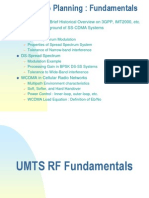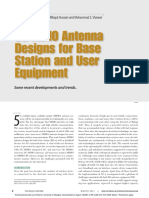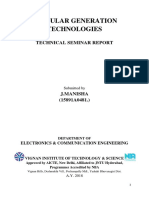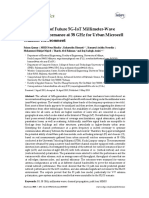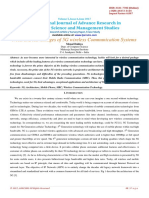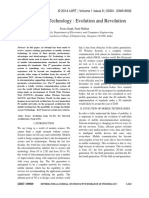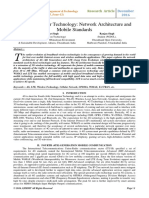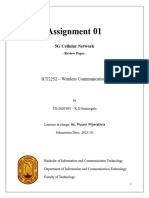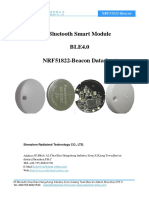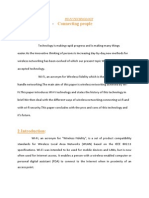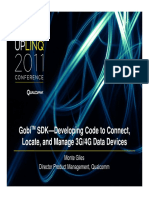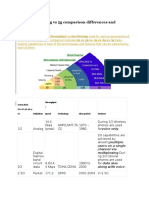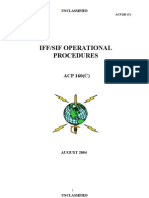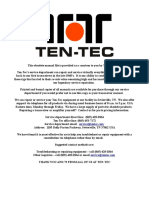Professional Documents
Culture Documents
Technologies For Move Towards 5G
Uploaded by
Anonymous izrFWiQOriginal Title
Copyright
Available Formats
Share this document
Did you find this document useful?
Is this content inappropriate?
Report this DocumentCopyright:
Available Formats
Technologies For Move Towards 5G
Uploaded by
Anonymous izrFWiQCopyright:
Available Formats
Volume 4, Issue 5, May– 2019 International Journal of Innovative Science and Research Technology
ISSN No:-2456-2165
Technologies for Move towards 5G
Haseeb Shams1 Sheraz Khalid2
1 2
Department of Electrical Engineering and Technology Department of Electrical Engineering, National University
Riphah International University of Computer and Emerging Sciences
Faisalabad, Pakistan Chiniot-Faisalabad, Pakistan
Muhammad Arshad Rasheed3 Muhammad Junaid Akram4
3 4
Department of Electrical Engineering, University of Department of Electrical Engineering, National University of
Engineering and Technology Computer and Emerging Sciences
Lahore, Pakistan Chiniot-Faisalabad, Pakistan
Abstract: - Data traffic is increasing day by day so does
the demand of higher speed which makes fifth
generation inevitable. In previous generations there
were some challenges that couldn’t be handled even by
4G, such as the spectrum crisis and high energy
consumption. 5G is the technology which will be the
solution to the requirements of today. For 5G, very high
frequencies with massive bandwidths and extraordinary
base stations are required. 5G will operate above 6
GHz. In this paper we are trying to describe some
disruptive technologies that will be helpful in the
achievement of high data rates in 5G. We will try to
describe these technologies by using previous literature.
The technologies include Machine to machine Fig 1:- Wireless Mobile Generation Service Type
communication (M2M), Massive MIMO, Millimeter
wave (mm wave) and smarter devices which means Cell phones in 5G will be operated on very high
device to device communication. Readers will have a bandwidth. 5G will have a wide area coverage and high
comprehensive overview of these technologies and will throughput. 5G is offering high tenacity for great mobile
be able to develop understanding about what 5G will users. It also offers finest Quality of service (QoS), huge
be? bandwidth, high data rates. As far as latency and reliability
requirements are expected, 5G should support applications
Keywords: - 6GHz, Millimeter Wave, Directional related to health, security and automotive applications etc.
Antennas, Channel Models, 5G, Cellular, Architecture, The researchers have already accepted that with respect to
MIMO, Long Term Evolution. 4G, 5G should achieve 10 times the spectral efficiency,
1000 times the system capacity, energy efficiency and data
I. INTRODUCTION rate [3]. 5G can achieve 10 Gb/s at low mobility and 1 Gb/s
at high mobility [3]. Internet is making our daily life more
We are living in the world of modern science. Science comfortable and efficient. But on the other hand it is said
has become an essential part of our life. We cannot that by 2020 there will be 50 billion connected devices [4].
consider of a single moment without science and its legacy.
Science has always been making our life easy and The question is that, what technologies will define it?
comfortable. During last few spans, science has brought How can we achieve huge bandwidths and high data rates
many big changes in telecommunications industry. We in 5G? The answers of these questions are provided
have mobile and wireless communication technologies that through some disruptive technologies which are discussed
have already been deployed which comprise Wi-Max, Wi- in this paper. These technologies include
Fi, LTE, 3G and 4G technologies. These technologies
differ from each other and consequently many differences Millimeter wave (mm wave)
have been noticed in the previous generations. Mobile data Massive MIMO
traffic has been increased globally and this will continue to M2M Communication
rise in coming years. This is the result of cloud computing Smarter devices Communication
and high definition video streaming in wireless networks
and other higher data rate hungry technologies. It is M2M (Machine to machine) communication
considered that in 2017 the data traffic of mobile phones is addresses base stations architectures of cellular systems. It
expected to exceed 6 EXA bytes per month. It is defined in is the time to change and reconsideration of up and
fig 1 how to change technology with the passage of time downlinks concepts[28]. Control channels and data
[1][2]. channels may change also. These changes will provide a
better route for flow of information towards different nodes
IJISRT19MY400 www.ijisrt.com 473
Volume 4, Issue 5, May– 2019 International Journal of Innovative Science and Research Technology
ISSN No:-2456-2165
in a network. These architectures may also define the radio (JTACS). 1G was typically modulated to 150 MHz and up
access network and the network core of the system. [10]. 2nd generation was divided into (TDMA) Time
Division Multiplexing Access and (CDMA) Code
Massive MIMO is multiple inputs and multiple Division Multiplexing Access [11]. It was operational
outputs. Many antennas are used to multiplex messages for frequency band is 900 to 1800 MHz covers Europe and
different devices. Base station design may need some Asia [11]. 850 to 1900 MHz covers US. In CDMA
architectural changes and it may lead to new type of operational frequency band is 800 MHz and 1900 MHz [7].
implementations [19]. In Massive MIMO systems, the Third generation was first used in 2001 [12]. There were
receiver and transmitter are equipped with a huge number two families of 3G that were 3GPP1 and 3GPP2[12].
of antenna rudiments typically tens or few hundreds in The technologies that were used in 3GPP were GPRS
number. It can also pointedly improve both spectral offers 114 Kbps, EDGE offers 384 Kbps, WCDMA offers
effectiveness and energy effectiveness. 1.9 Mbps speed [8]. The present generation is 4G and it
was first used by South Korea in 2007.The technologies
Spectrum has become insufficient at microwave that are used is mobile WI- MAX, LTE, OFDMA. It
frequencies. While on the other hand we see a sufficient achieved the data rate is about 36 Mbps [13].
spectrum in mm wave frequencies (57–66, 71–76, and 81–
86 GHz) [2]. “Millimeter Wave technologies have already III. MILLIMETER WAVE
been adopted (IEEE 802.11ad) and already been used for
hollow applications such as small-cell backhaul”. We will Now a day’s terrestrial wireless systems have limited
discuss applications of mm wave in 5G. In smarter devices their operations to small range of microwave frequencies.
D2D communication is faster technique move towards 5G Their range is from several hundred MHz to few GHz. This
because it is interconnected device to device which may spectral band has nearly fully occupied, so more bandwidth
attain their efficiency in linear manners. In which discuss is needed. Fortunately large amount of idle spectrum exists
the macro-dominated evolution of 5G and D2D in mm wave range 30-300 GHz and wavelengths are 1-
communication scenario. 10mm [14]. Several GHz are also feasible in range of 20-30
GHz [14]. Idle spectrum of mm wave is unsuitable for the
The objective of this paper is to discuss some mobile communications and the reason is hostile
disruptive technologies for 5G by using previous literature. propagation qualities, low diffractions and penetration
The study shows that these disruptive technologies may through subjects etc. Many bands are also feasible
become key technologies for 5G. These technologies will including the license free In mm wave antenna arrays are
increase data rate and the problem of increased data traffic key features. In utilization of one side link or both side
can be solved through these technologies. The other link, we can maintain antenna apertures constant
objective is to give an overview to the readers about keeping arrays large[5]. The impact of interference can
disruptive technologies that are currently used in 5G. The be reduced by using adaptive arrays of narrow beams. If
remaining part of this review is organized as follows. We we have sufficient array gain then meaningful
discussed key technologies that can be a part of 5G system. communication can be made possible, for this we need
Importance of these technologies is described in the context some new access protocols that work when transmitter
of 5G and then impacts of these technologies are also emits in definite directions and receivers receive form
outlined and lastly conclusions are drawn. definite directions. Some operational algorithms are also
needed that adjust quickly when beams are stopped by
II. LITERATURE REVIEW something.
Initial start of our communication system was called If we talk about the hardware of mm wave systems,
Mobile Radio Telephone System. It was known as Zero chiefly ADC and DAC are used. One of the alternatives is a
generation. It was an analog cellular system. In 0 G some mixture construction in which beam establishing is
technologies that were used Mobile Telephone System performed in analog at RF. Another alternative can be
(MTS), Advance Mobile Telephone System (AMTS), performed by connecting RF chain to 1 bit ADC/DAC and
Improve Mobile Telephone Service (IMTS) and Push TO power consumption requirements should be used low. In
Talk (PTT) and [5]. There were only twenty five channels this scenario beam forming would be performed digitally
and no roaming facility [9]. Its range was 20 Km, in this but data will be noisy. The optimization of different
range local telephones were connected [5]. Next generation transceiver techniques is one of the research challenges.
was called 0.5G.In this generation there were used Auto When we talk about mm wave then backhauling concept is
radio puhelin (ARP) technique [5]. This was the first public also considerable. In fig.2 at mm waves backhauling the
mobile phone network. It was launched in Finland in 1971 data is now accepted commonly among the equipment
[9]. Its 8 channels were operated on 150 MHz in the range providers. Siemens networks in New York at 72 GHz,
of (147.9- 154.8 MHz). Power transmission was in 1 to 5 Nokia, Austin and Korea at 28 and 38 GHz, Samsung
watt range [9]. First generation was also analog in New York have already arranged prototypes for
communication system. There was no data achievement in measurement drives [2,32]. The figure1 illustrates dense
this Generation. Some techniques Nordic Mobile urban environment in which Macro cell BSc (M-BSs) are
Telephone (NMT), Advance Mobile Phone service located on the roof top and small cell base stations (BSs)
(AMPS), Japanese Total Access Communication system are in street corners [4]. Networks are 3 dimensional in
IJISRT19MY400 www.ijisrt.com 474
Volume 4, Issue 5, May– 2019 International Journal of Innovative Science and Research Technology
ISSN No:-2456-2165
big cities and minor cells are situated at diverse Due to increase the signal power and low intrusion,
heights, altitudes for different user categories. BSs and mm the gain exceeds to 10x spectrum increase. This is achieved
wave backhaul systems will be installed together on band at through directional beam forming at both transmitter and
60 GHz multipoint distribution service at 28-30 GHz the E receiver. Studying different papers we can conclude that
band at 71-76 GHz, 81-86 GHz and 92-95 GHz [6,8]. From Millimeter wave requires comprehensive fluctuations in the
this we can conclude that several tens of GHz could be system. Millimeter wave has a strong influence in both
utilized for 5G. The basic difference between microwave component and structural designs. It is a disruptive
and mm wave is responsive to obstructions. Research study technology for 5G.
on mm wave cellular system tells us about the outcomes
such as infrastructure and relays about complex channel IV. MASSIVE MIMO
model analysis.
In 2010 Thomas L. Marzetta proposed massive
MIMO system which incorporates multiple input and
multiple output (MIMO) concepts. Massive MIMO
terminology also called as large scale antenna system or as
a large scale MIMO is a form of lot of user MIMO in
which the base station antennas are more than the number
of devices each signaling resource. Energy efficiency ha
huge data rate are important for 5G system. By massive
MIMO we can achieve the both with the increasing number
of antennas at base stations and operating in time division
duplex (TDM) mode. There is also effect of user location
distribution (ULD) distinction on the energy efficiency of a
load-adaptive massive MIMO system. [45].
Massive MIMO is a possible authorized technology
Fig 2:- Mm Wave Urban Environment and Back Hauling for concurrently increasing the reliability and highest data
Scenario [32] rates to reducing the energy loss. The capacity and solidity
of wireless communication systems is increased with the
Street lamps, utility poles etc. Whenever mobile use of multiple input antennas and multiple output
device is connected to such networks and massive data antennas. Multiple-input multiple- output wireless systems
exchange occurs in the coverage area of mm wave small are now part of present standards and will deploy
cell, M-BSs will assist the UE to perform mm wave cell throughout the world in 5G. Typical MIMO installations
discovery. In this scenario transceiver of mobile device has for the use of access points or base stations with relatively
to be activated and M-BSs cooperate with mm wave BS to few(less than 10) antennas [21], and the corresponding
enable seamless handover [5,7]. A data rate comparison is improvements in spectral efficiency has been relatively
made in Fig.3 between technologies in terms of 5% outage increased. To achieve the higher data rates and multiple
rates and mean [31]. Microwave systems have shown low users access in MIMO concept uses more antennas (100 or
rates as compare to mm wave. more) at each base station, this phenomena is often referred
to as massive MIMO [15].
With accordance to Henderson Clark model, we can
say that Massive MIMO is a key technology for 5G. “There
is an inventible angle faded of the propagation in turn of
single user Massive MIMO that can be constructed by a lot
of antennas and that can be varied in different devices [23].
To enable the channel estimation through uplink model,
time division multiplexing and lot of antennas are used at
base station with no limit in massive MIMO. It enables the
new deployments, structure and architectures. Low gain
resonant antennas with arrays have been direct replacement
in macro base stations that can be the source of other
deployments. Moreover the control principles of collected
arrays of the antennas will also be needed”[3].
Fig 3:- Comparison of Data Rate between 50 MHz and 500
MHz Microwave System Bandwidth with Use of Single
MIMO [31]
IJISRT19MY400 www.ijisrt.com 475
Volume 4, Issue 5, May– 2019 International Journal of Innovative Science and Research Technology
ISSN No:-2456-2165
not effected the frequency because it specifically
depends upon the environment in slow fading.
In case of free space, we refer to as a full vacuum state
but in reality an ideal space in common will be denoted
as a free space. There are no reflections, refractions and
diffractions in a vacuum environment. Therefore, the
radiated speed of the radio waves is identical to the
speed of light.
The multipath effect is a main factor that effects on a
wireless communication. The signals are not fading at
the receiving end over a single path in a wireless mobile
environment but are the superposition of many reflected
signal in wireless mobile. The phase of different
reflected waves and approach time are not equal but
super imposed signals may result by signal spreading or
failing.
Doppler shift occurs when the transmitter of a signal is
Fig 4:- Cell Data Range Comparison [33]
moving in accordance to the receiver end. If we shift the
frequency of the signal with the relative movement that
A comparison of antenna range of 2048, 4096 and
makes it different at receiving end then further at
8192 is shown in Fig.4 [33]. These antennas are using 50
transmitting end. Each frequency is received by the
MHz and radiating 12 watts. These antennas are serving
receiver is different from the transmitter. This
1000 users in a distance range of 6 KM. A key advantage
phenomenon is best in the sound waves for observation
of the massive MIMO concept lies in its possible energy
and understanding.
gain in energy efficiency. In an ideal channel state
information of massive MIMO system, a user can access
Massive MIMO is useful for the 5th generation
the same uplink throughput with a single antenna base
network in many ways as under [19,20,24]:
station with the required transmit power of 1⁄Nt [16]. For
each end user, power to the same throughput on scales of
It has increased the specific resolution as compared
1⁄Nt in channel state information, represents that specific
with the conventional MIMO and the resources of
power savage at the end user. In overall same transmit
specific dimensions without the gain in base stations
power and the dissipation of received signal to noise ratio
compression.
in scaling law for downlink principles. For particular power
The focus on beam forming with an extreme intensity
amplifier is required to generate 1⁄Nt of the whole power in
into micro regions is decreasing the interference.
massive MIMO. The specific implications in terms of
Massive MIMO can also help to increase the spectral
design, cost, heat dissipation, simplicity and efficiency of
efficiency and energy efficiency in the case of
power amplifiers can be drawn. These terminologies for the
magnitude related with the particular antenna system.
increase of power efficiency can be helpful to reduce the
large scale path losses in multi-meter wave frequencies and
We can say that the Massive MIMO system has a
it can increase the operational range of the overall system
greater potential and key authorizing technology for the
[15]. There is some algorithm that’s inhance the efficiency
fifth generation (5G) with these benefits.
of the high complexity of channel estimation. In which
sparse channel estimation algorithm that’s has low
V. M2M COMMUNICATION
complexity it distinct the channel taps from the noise space
with the help of discrete Fourier transform (DFT) channel
A. M2M Communication in LTE
estimation and it can achieve the minimum time square
The enhancements for M2M in LTE have been made
error performance[46].
by 3GPP [18]. Enhancements are overload control, cost
reduction, power saving and signaling overhead etc. which
In wireless transmission, the channels are influenced
are summarized in Table I.
by the factors in which shadow effect, the free-space
propagation loss, the multipath effects and the Doppler
effects are included [17,22 ,25,26].
Shadow effect, also called as slow fading, is a blockage
due to the building or the receiving antenna topography
that produce electromagnetic shadow. Strength of the
antenna due electromagnetic field will be changed also.
If we compare slow fading and fast fading then in fast
fading that’s changes macroscopically and it is
normally dignified on a large specific scale. Speed has
IJISRT19MY400 www.ijisrt.com 476
Volume 4, Issue 5, May– 2019 International Journal of Innovative Science and Research Technology
ISSN No:-2456-2165
Release of LTE Feature meet M2M requirements. Different techniques are available
that can support association of machine and human traffic.
Preference indication of UE The techniques like scheduling prioritization that reduces
Type Rel-11 in power the overhead are used. By this technique effect of machine
2012 Control of overloading of RAN traffic to human can be reduced [29].
Low Cost Devices
(Cat-0) UE category of low Low cost devices are one of the supporting elements
Type Rel-12 in cost for M2M in LTE. The lowest LTE device is category -1
2014 For UE Power saving mode device; it has two RX antennas and can support 5 Mbps in
For eNB parameter tuning UE uplink and 10 Mbps in downlink.
assistance information
The new introduced device is thrown in (category- 0)
that has following features:
Type Rel-13 in UE category of low-cost
2016 It has only one RX antenna and antenna chain.
Increase the coverage Peak data rates are reduced to 1 Mbps in uplink and
Increase the power saving downlink [18,28].
Table 1: - Enhancements for M2M in LTE [18,30] Single Rx has reduced 4 dB in downlink channels
[18]. Due to reduced power breakdown of efficiency in
Rel-11, Rel-12 and Rel-13 are different releases of uplink channels has occurred. Table 2 has shown a
LTE. Rel-13 is a new device of category 0 of less lower comparison of LTE FDD device categories. Comparison is
complexity. Listed features in Table 1 show that LTE can made between different releases or different categories.
Capability of devices Type Rel-8 in Cat-4 Type Rel-8 in Cat-I Type Rel-12 in Cat-0 Type Rel-13 in low-
cost
Peak rate of downlink 0.15 Gbps 0.01 Gbps 0.001 Gbps 0.001 Gbps
Peak rate of uplink 0.5 Gbps 0.05 Gbps 0.001 Gbps 0.001 Gbps
No. of receiver chains RF 2 2 1 1
No. of spatial layer of 2 2 1 1
downlink
Bandwidth of device Full Full Half Half
Mode of Duplex 0.02 GHz 0.02 GHz 0.02 GHz 0.0014 GHz
Modem complexity of Cat-I 1.25 or 125% 1 or 100% 0.5 or 50% 0.25 or 25%
Maximum power of TX 23 dBm 23 dBm 23 dBm -20 dBm
Table 2: - Comparison of LTE FDD Device Categories [18,28]
Device Power Saving 11[30]. Rel-13 is also capable of sending info to the
Power saving and Power preference mode are two network about its traffic type.
features that have been presented in LTE to save or reduce
power feeding. B. M2M Communication in 5G
Wireless communication has become a valuable
If the system is using power preference mode, it tells important part of our daily life like water and electricity. As
the network to use low power consumption. Then system the need of communication has been increased, this has
network takes reduced measurements and keep device for given rise to new types of requirements. These
more sleep time to reduce power consumption. There was a requirements are given below:
power saving mode in Rel-12 which works when UE is
available but out of network range. UE can only be seen in Massive connected devices
power off mode or sleep mode [28]. Currently system is operating at few hundred devices
but M2M system requires more than 104 connected devices
Rel-13 [27]. Some examples are sensors, smart grid components
In this release power saving mode is also introduced. etc.
Some techniques regarding power saving mode are half
duplex operation, reducing control channel overhead, High link reliability
system gaining time etc. To stop system overload in M2M We see around the world the things that are dealing
Extended Access Barring (EAB) was introduced in Rel- with safety or production are connected to wired system
instead of wireless system because wireless system gives
IJISRT19MY400 www.ijisrt.com 477
Volume 4, Issue 5, May– 2019 International Journal of Innovative Science and Research Technology
ISSN No:-2456-2165
less security [30]. When we talk about shifting our system VI. SMARTER DEVICES
from wired to wireless it should be reliable then.
Cellular designs have factually depends upon them
Low latency obvious part of “cells” as basic units within the radio
This requirement is more important than others access network. Below such a strategy hypothesize, a
because transferring or data in required time is very device attains service by forming an uplink and downlink
important. Example is vehicle to X-connectivity in which joining, carrying both mechanism and data circulation [34],
critical messages are sent in required time interval [29]. with the BS impressive cell where the device is situated. In
which base station thickness is growing fast, convey by the
increase of varied networks. While various networks were
previously consistent in 4G, the architecture does not
intend to support them. Network densification will require
the most of changes in 5G as compared old terminologies
[35]. The need for supplementary spectrum will
unavoidably top to the coexistence of frequency bands with
very dissimilar broadcast features within the same system.
A new thought called centralized base band associated to
the idea of cloud radio access networks is developing [36].
Device centric Architecture is mainly linked with device to
device communication and remaining technologies.
If we talk about simple daily routine device to device
Fig 5:- Population Size and Rate of Data in Operating communication so our conclusion is about that everything
Regions is connected each other but if there is something
disconnected then we have suffer some major flaws so a
Figure 5 is a plot between data rates and population, simple depict fig 6 is to understand the D2D.
which shows the requirements of M2M with increase in
population. R1 highlights current situation, which describes
us that with increase in population data rates decreases. R5
region shows that due to some physical and informational
limitations. R3 region indicates the M2M where sensors
and machines connected emits data. Current system is not
able to deal with large number of data traffic from such
devices. Survey says that currently system deals with 5
devices at 2 Mb/s but 10K devices requiring 1 kb/s. R4
refers to the region which shows the low latency and high
consistency needs, with small rate per device by average.
M2M is measured to be a key technology in future for 5G
developments. The probable development in the Mobile
Broad Band (MBB) from IMT-2000 and IMT advanced
towards 2020.
Machine type communication (MTC) use causes two
different scenarios for 5G system future design [18].
Low cost, low power consumption
Mission critical Fig 6:- A Depict Scenario of D2D Communication
Electricity, gas metering is one of the MTC use case. Cellular link communication and D2D
In critical M2M scenarios, automation industries and communication as shown above. Move towards D2D
controlling of robots are very important areas in terms of communication because there is a large energy gap may
latency in quality of service requirements. 2G, 3G, 4G cause the losses so D2D is better solution for this.
wireless systems that are currently active cannot meet the Therefore different scenario move towards D2D so in
requirements. It is said 5G is the system that can meet the which efficient of energy control, jointing strength
requirements of future internet industry. approach and efficient energy resource allocation [39][40].
For 2G/3G and even 4G, most assigned spectrums are
The most important requirement of M2M in 5G are mostly below 3 GHz. So that uses of spectrum up-to the lot
[18]: of efficiency. Therefore a new possible spectrum for the
future establishment mobile communication. It seems that
Max permitted end-to-end latency the new obtainable future generation spectrum. Then its
Reliability.
IJISRT19MY400 www.ijisrt.com 478
Volume 4, Issue 5, May– 2019 International Journal of Innovative Science and Research Technology
ISSN No:-2456-2165
range above the 3GHZ and its improve the efficiency and REFERENCES
coverage [37][38][43].
[1]. Pirinen, Pekka. "A brief overview of 5G research
If we consider the download sharing resources activities." In 5G for Ubiquitous Connectivity
between the cellular users and D2D links; there is each (5GU), 2014 1st International Conference on, pp. 17-
D2D link uses multiple cellular users channel and each 22. IEEE,2014.
cellular user uses multiple D2D links so there is a quality of [2]. Dehos, J. L. Gonzalez, A. D. Domenico, D. Ktenas,
Service (QOS) will reliable for each cellular user and and L. Dussopt, “Millimeter-wave access and
improve the cellular utilization spectrum [41][42]. backhauling: the solution to the exponential data
traffic increase in 5G mobile communications
systems?,” IEEE Communications Magazine, vol.
52, no. 9, pp. 88–95, Sep. 2014.
[3]. C.-X. Wang et al., "Cellular architecture and key
technologies for 5G wireless communication
networks," IEEE Communications Magazine, vol.
52, no. 2, pp. 122–130, Feb. 2014.
[4]. Osseiran et al., "Scenarios for 5G mobile and
wireless communications: The vision of the METIS
project," IEEE Communications Magazine, vol. 52,
no. 5, pp. 26–35, May 2014.
[5]. Liu, Ruizhi, Yangping Zhao, and Ke Wu.
"Millimeter-wave sourceless receiver embedded
with DoA estimation." In Microwave Conference
(EuMC), 2016 46th European, pp. 69-72. IEEE,
2016.
[6]. Rodriguez, Ignacio, Huan C. Nguyen, Troels B.
Sorensen, Jan Elling, Jens Age Holm, Preben
Mogensen, and Benny Vejlgaard. "Analysis of 38
GHz mmWave propagation characteristics of urban
Fig 7:- Move Towards 5G scenarios." In European Wireless 2015; 21th
European Wireless Conference; Proceedings of, pp.
In figure 7 shows the illustration towards 5g and 1-8. VDE, 2015.
device to device communication is to involve moving [7]. Ghaleb, Abdulziz M., Ali Mohammed Mansoor, and
manufacturing machines as a D2D caching helper in Rodina Ahmad. "An Energy-Efficient User-Centric
manufacturing automation, where massive contents shaped Approach High-Capacity 5G Heterogeneous Cellular
by touching Internet of Things (IoT) tackles should be Networks." INTERNATIONAL JOURNAL OF
distributed to the advantage network setup and then ADVANCED COMPUTER SCIENCE AND
forwarded to remote human operators by dependable and APPLICATIONS 9, no. 1 (2018): 405-411.
high-rate radio links [39][41]. For upholding the [8]. Kwon, Jae-Yong, Tae-Weon Kang, and No-Weon
dependability of data connections, unusual contents Kang. "$ V $-Band Waveguide Micro-calorimeter
diffusion modes coupled with analytical mode selection for Millimeter-Wave Power Standards." IEEE
strategies based on the expected radio link situations are Transactions on Instrumentation and Measurement
presented, and then their efficiency is established by 66, no. 6 (2017): 1598-1604.
assessment [44]. [9]. “What is Mobile Radio Telephone System or 0G
(Zero Generation) ?,” ClearDoubts. [Online].
VII. CONCLUSIONS Available:http://www.cleardoubts.com/technolog
y/what-is-mobile-radio-telephone-system-or-0g-and-
This paper has discussed some disruptive what-is-0-5g/. [Accessed: 28-Dec-2018].
technologies for 5G. We can say that these technologies [10]. “Technologies used in 1G or First generation
can lead to some fundamental changes in cellular networks of Wireless Telecommunication Technology,”
at node and design level to accomplish the 5G goals. This Clear Doubts. [Online]. Available:
paper has shown a survey on these technologies. What are http://www.cleardoubts.com/technology/technologie
the changes made in these technologies in order to attain s-used-in-1g-or-first-generation-of-wireless-
the high data rates, are also discussed in this article. telecommunication-technology/. [Accessed: 28-Dec-
Importance of these technologies is also highlighted. 2016].
Hence, from our survey we can say that Massive MIMO, [11]. “How 2G Works | FDMA | CDMA | TDMA,”
mm Wave and M2M techniques and smarter devices could FreeWimaxInfo.com, Dec
be the basics of 5G communication technology. 2016.[Online].Available:http://freewimaxinfo.com/h
ow-2g- works.html. [Accessed: 28-Dec-2016].
IJISRT19MY400 www.ijisrt.com 479
Volume 4, Issue 5, May– 2019 International Journal of Innovative Science and Research Technology
ISSN No:-2456-2165
[12]. “What is 3G (third generation of mobile telephony)? Massive MIMO in 5G." In 2018 International
- Definition from WhatIs.com,” SearchTelecom. Conference on Microwave and Millimeter Wave
[Online]. Available: Technology (ICMMT), pp. 1-3. IEEE, 2018.
http://searchtelecom.techtarget.com/definition/3G. [24]. Panzner, Berthold, Wolfgang Zirwas, Stefan Dierks,
[Accessed: 28-Dec-2016]. Mads Lauridsen, Preben Mogensen, Kari Pajukoski,
[13]. “What is 4G (fourth-generation wireless)? - and Deshan Miao. "Deployment and implementation
Definition from WhatIs.com,” strategies for massive MIMO in 5G." In Globecom
SearchMobileComputing. [Online]. Available: Workshops (GC Wkshps), 2014, pp. 346-351. IEEE,
http://searchmobilecomputing.techtarget.com/definit 2014.
ion/4G. [Accessed: 28-Dec-2016]. [25]. Ma, Lujuan, Xiaoping Deng, Jiaheng Wang,
[14]. J. G. Andrews et al., "What will 5G be?," IEEE Yongming Huang, and Fengfeng Shi. "Downlink
Journal on Selected Areas in Communications, vol. Resource Sharing in Multichannel Device-to-Device
32, no. 6, pp. 1065–1082, Jun. 2014. Communication." IEEE Wireless Communications
[15]. L. Swindlehurst, E. Ayanoglu, P. Heydari, and F. Letters (2019).
Capolino, "Millimeter-wave massive MIMO: The [26]. Jungnickel, Volker, Konstantinos Manolakis,
next wireless revolution?," IEEE Communications Wolfgang Zirwas, Berthold Panzner, Volker Braun,
Magazine, vol. 52, no. 9, pp. 56–62, Sep. 2014. Moritz Lossow, Mikael Sternad, Rikke Apelfrojd,
[16]. H. Q. Ngo, E. G. Larsson, and T. L. Marzetta, and Tommy Svensson. "The role of small cells,
"Energy and spectral efficiency of very large coordinated multipoint, and massive MIMO in 5G."
Multiuser MIMO systems," IEEE Transactions on IEEE Communications Magazine 52, no. 5 (2014):
Communications, vol. 61, no. 4, pp. 1436–1449, 44-51.
Apr. 2013. [27]. Ali, Kaouther Taleb, Sonia Ben Rejeb, and Ziéd
[17]. F. Hu, Ed., Opportunities in 5G networks: A Choukair. "Energy Conservation Strategy for M2M
research and development perspective. United Differentiated Services in 5G/HetNet." In 2018 6th
States: CRC Press, 2016, ch. 7 ‘Massive MIMO for International Conference on Multimedia Computing
5G’, pp. 113–148. and Systems (ICMCS), pp. 1-6. IEEE, 2018.
[18]. R. Ratasuk, A. Prasad, Z. Li, A. Ghosh, and M. [28]. Dighriri, Mohammed, Gyu Myoung Lee, and Thar
Uusitalo, “Recent advancements in M2M Baker. "Applying Scheduling Mechanisms Over 5G
communications in 4G networks and evolution Cellular Network Packets Traffic." In Third
towards 5G,” 2015 18th International Conference on International Congress on Information and
Intelligence in Next Generation Networks, pp. 52– Communication Technology, pp. 119-131. Springer,
57, 2015. Singapore, 2019.
[19]. Yamaguchi, Satoshi, Hikaru Watanabe, Hideharu [29]. Wani, Tahir Mohammad, Sahil Nazir Pottoo,
Yoshioka, Yasuo Morimoto, Hidevuki Nakamizo, Muneer Ahmad Dar, and Sameer Ahmad Mir.
Koii Tsutsumi, Shintaro Shinjo et al. "Development "Enabling Technologies for 5G Cellular Networks."
of 28GHz band Massive MIMO Antenna RF architecture 2 (2018): M2M.
Frontend Module for 5G." In 2018 IEEE [30]. Schulz, Philipp, Maximilian Matthe, Henrik Klessig,
International Symposium on Antennas and Meryem Simsek, Gerhard Fettweis, Junaid Ansari,
Propagation & USNC/URSI National Radio Science Shehzad Ali Ashraf et al. "Latency critical IoT
Meeting, pp. 629-630. IEEE, 2018. applications in 5G: Perspective on the design of
[20]. Zhang, Jiayi, Linglong Dai, Xu Li, Ying Liu, and radio interface and network architecture." IEEE
Lajos Hanzo. "On low-resolution ADCs in practical Communications Magazine 55, no. 2 (2017): 70-78.
5G millimeter-wave massive MIMO systems." IEEE [31]. R. W. Heath Jr., “What Is the Role of MIMO in
Communications Magazine(2018). Future Cellular Networks: Massive? Coordinated?
[21]. Xiao, Ke, Jianyu Zhao, Moqi Jiang, and Fenghe mmWave?,” ICC Wksp. Plenary: Beyond LTE-A,
Wang. "An anti-eavesdropping scheme for hybrid Budapest, Hungary; slides at
multicast services with massive MIMO in 5G." [32]. http://users.ece.utexas.edu/~rheath/presentations/201
Journal of Computational Methods in Sciences and 3/Future_of_MIMO_Plenary_Heath.pdf.
Engineering Preprint (2018), PP:1-11. [33]. M. Zhadobov et al., “Millimeter-Wave Interactions
[22]. Shinjo, Shintaro, Keigo Nakatani, Jun Kamioka, with the Human Body: State of Knowledge and
Ryota Komaru, Hifumi Noto, Hideyuki Nakamizo, Recent Advances,” Int’l. J. Microwave and Wireless
Satoshi Yamaguchi, Shigeru Uchida, Akihiro Technologies, vol. 3, Special Issue no. 02, 2011, pp.
Okazaki, and Koji Yamanaka. "A 28GHz-band 237–47.
highly integrated GaAs RF frontend Module for [34]. P. Baracca, F. Boccardi, and N. Benvenuto, “A
Massive MIMO in 5G." In 2018 IEEE MTT-S Dynamic Clustering and Resource Allocation
International Microwave Workshop Series on 5G Algorithm for Downlink CoMP Systems with
Hardware and System Technologies (IMWS-5G), Multiple Antenna UEs,”
pp. 1-3. IEEE, 2018. http://arxiv.org/abs/1311.5114, 2013.
[23]. Guo, Chong, Chang Shu, Fei Huang, Tao Sun, Ling [35]. J. Andrews, “The Seven Ways HetNets Are a
Tian, and Wei Hong. "Design and Implementation of Paradigm Shift,” IEEE Commun. Mag., vol. 51, no.
a Highly Integrated 8-Channel Transceiver for 3, Mar. 2013, pp. 136–44.
IJISRT19MY400 www.ijisrt.com 480
Volume 4, Issue 5, May– 2019 International Journal of Innovative Science and Research Technology
ISSN No:-2456-2165
[36]. Y. Kishiyama et al., “Future Steps of LTE-A:
Evolution towards Integration of Local Area and
Wide Area Systems,” IEEE Wireless
Commun., vol. 20, no. 1, Feb. 2013, pp. 12–18.
[37]. “C-RAN: The Road Towards Green RAN,” China
Mobile Research Inst., Beijing, China, white paper,
v. 2.5, Oct. 2011.
[38]. T. D. Hoang, L. B. Le, T. Le-Ngoc, Energy-efficient
resource allocation for D2D communications in
cellular networks, IEEE Transactions on Vehicular
Technology 65 (9) (2016) 6972–6986.
[39]. Gao, X. Sheng, J. Tang, W. Zhang, S. Zou, M.
Guizani, Joint mode selection, channel allocation
and power assignment for green Device-to-Device
communications, in: 2014 IEEE International
Conference on Communications (ICC), 2014, pp.
178–183.
[40]. W. O. Oduola, X. Li, L. Qian, Z. Han, Power control
for Device-to-Device communications as an
underlay to cellular system, in: 2014 IEEE
International Conference on 415 Communications
(ICC), 2014, pp. 5257–5262.
[41]. J. Ding, L. Jiang, C. He, Energy-efficient power
control for underlaying D2D communication with
channel uncertainty: User-centric versus network-
centric, Journal of Communications and Networks
18 (4) (2016) 589–599.
[42]. W. Zhao and S. Wang, “Resource sharing scheme
for device-to-device communication underlaying
cellular networks,” IEEE Trans. Commun., vol. 63,
no. 12, pp. 4838–4848, Dec. 2015.
[43]. K. Yang, S. Martin, C. Xing, J. Wu, and R. Fan,
“Energy-efficient power control for device-to-device
communications,” IEEE J. Sel. Areas Commun., vol.
34, no. 12, pp. 3208–3220, Dec. 2016.
[44]. Lujuan Ma, Xiaoping Deng, Jiaheng Wang,
“Downlink Resource Sharing in Multichannel
Device-to-Device Communication” IEEE wireless
Communications 2018.
[45]. Elshaer, Hisham, Federico Boccardi, Mischa Dohler,
and Ralf Irmer. "Downlink and uplink decoupling: A
disruptive architectural design for 5G networks." In
Global Communications Conference
(GLOBECOM), 2014 IEEE, pp. 1798-1803. IEEE,
2014.
[46]. Abuibaid, M.A. and Çolak, S.A. Energy-efficient
massive MIMO system: Exploiting user location
distribution variation. AEU-International Journal of
Electronics and Communications, 72, pp.17-25,
2017.
[47]. Khan, I. and Singh, D. Efficient compressive sensing
based sparse channel estimation for 5G massive
MIMO systems. AEU-International Journal of
Electronics and Communications, 89, pp.181-190,
2018.
IJISRT19MY400 www.ijisrt.com 481
You might also like
- Pharmaceutical Waste Management in Private Pharmacies of Kaski District, NepalDocument23 pagesPharmaceutical Waste Management in Private Pharmacies of Kaski District, NepalAnonymous izrFWiQNo ratings yet
- Introduction to ZigBee Wireless TechnologyDocument33 pagesIntroduction to ZigBee Wireless TechnologyrayedkhanNo ratings yet
- Platelet-Rich Plasma in Orthodontics - A ReviewDocument6 pagesPlatelet-Rich Plasma in Orthodontics - A ReviewAnonymous izrFWiQNo ratings yet
- UMTS RF FundamentalsDocument60 pagesUMTS RF Fundamentalsericsson3gppNo ratings yet
- 5G MIMO Antenna Designs For Base Station and User Equipment: Some Recent Developments and TrendsDocument13 pages5G MIMO Antenna Designs For Base Station and User Equipment: Some Recent Developments and TrendsKrithigasri MurugesanNo ratings yet
- 5G Wireless System Report Provides Insights into 5G Architecture and EvolutionDocument11 pages5G Wireless System Report Provides Insights into 5G Architecture and EvolutionKhawaja RameezNo ratings yet
- Extended PRM - RPS Overview - Nov 2018 - 20181119Document10 pagesExtended PRM - RPS Overview - Nov 2018 - 20181119Cagdas SoyNo ratings yet
- Preparation of Your Project Report (5G Standards)Document6 pagesPreparation of Your Project Report (5G Standards)AneelaMalikNo ratings yet
- DL SE improved 9.44% in LTC district BANDAR SRIBHAWONODocument5 pagesDL SE improved 9.44% in LTC district BANDAR SRIBHAWONOherry SimamoraNo ratings yet
- Nokia Academy RA4120-60A: Lte Rpess LTE - EPS OverviewDocument69 pagesNokia Academy RA4120-60A: Lte Rpess LTE - EPS Overviewmuhammad fadlun (RAMA)No ratings yet
- A Comprehensive Review On The Feasibility and Challenges of Millimeter Wave in Emerging 5G Mobile CommunicationDocument7 pagesA Comprehensive Review On The Feasibility and Challenges of Millimeter Wave in Emerging 5G Mobile CommunicationAnant SinhaNo ratings yet
- JETIR2011319Document8 pagesJETIR2011319Sushmitha ThulasimaniNo ratings yet
- 5G Heterogenous NetworkDocument9 pages5G Heterogenous NetworkBhumika PiplaniNo ratings yet
- Wireless Evolution With 4G Technologies: Prof. D. U. Adokar, Priti J. RajputDocument11 pagesWireless Evolution With 4G Technologies: Prof. D. U. Adokar, Priti J. RajputNebiye SolomonNo ratings yet
- A Comprehensive Study: 5G Wireless Networks and Emerging TechnologiesDocument6 pagesA Comprehensive Study: 5G Wireless Networks and Emerging TechnologiesafzhussainNo ratings yet
- Overview of Millimeter Wave Communications For Fifth-Generation (5G) Wireless Networks-With A Focus On Propagation ModelsDocument15 pagesOverview of Millimeter Wave Communications For Fifth-Generation (5G) Wireless Networks-With A Focus On Propagation ModelsBob builderNo ratings yet
- Study of Challenges in Migration To 5G NetworkDocument23 pagesStudy of Challenges in Migration To 5G NetworkBezawit MekonnenNo ratings yet
- Issues and Challenges in 5G Mobile NetworkDocument7 pagesIssues and Challenges in 5G Mobile NetworkIJRASETPublicationsNo ratings yet
- 5g PDFDocument10 pages5g PDFChaudhry Asad IqbalNo ratings yet
- Tech Sem Manisha Docx. 2Document19 pagesTech Sem Manisha Docx. 2sonyNo ratings yet
- A Literature Survey On Applications of 5G Technologies For Water Resource ManagementDocument8 pagesA Literature Survey On Applications of 5G Technologies For Water Resource ManagementIJRASETPublicationsNo ratings yet
- VISION AND CHALLENGES OF 6G TECHNOLOGYDocument7 pagesVISION AND CHALLENGES OF 6G TECHNOLOGYvikas chawlaNo ratings yet
- The Evolution of 5G Mobile Communication Standard Technology and Its ImplementationDocument11 pagesThe Evolution of 5G Mobile Communication Standard Technology and Its ImplementationMuhammad HussainNo ratings yet
- The Next Generation Mobile Wireless Cellular NetwoDocument7 pagesThe Next Generation Mobile Wireless Cellular NetwoNguyễn Hoàng DuyNo ratings yet
- Cloud Technologies For Flexible 5G Radio Access NetworksDocument12 pagesCloud Technologies For Flexible 5G Radio Access Networksmalli gaduNo ratings yet
- 773 2.a Survey On Mobile Communications and Network TechnologiesDocument5 pages773 2.a Survey On Mobile Communications and Network TechnologiesErena KenoNo ratings yet
- Massive Mimo, MM Wave and 5G Technology Insights and ChallengesDocument19 pagesMassive Mimo, MM Wave and 5G Technology Insights and ChallengesPetrut AlexNo ratings yet
- 1374-Article Text-2545-1-10-20210406Document9 pages1374-Article Text-2545-1-10-20210406Subhi RosdianNo ratings yet
- 4G-Beyond 3G and Wireless Networks: Indira Gandhi National Open University (IGNOU), Delh, IndiaDocument8 pages4G-Beyond 3G and Wireless Networks: Indira Gandhi National Open University (IGNOU), Delh, IndiaChara SukaNo ratings yet
- Towards The 5th Generation of Wireless Communication SystemsDocument15 pagesTowards The 5th Generation of Wireless Communication SystemsrajibuleceNo ratings yet
- Research Paper On Future of 5G Wireless System: June 2021Document6 pagesResearch Paper On Future of 5G Wireless System: June 2021Getachew BefekaduNo ratings yet
- 4G As A Next Generation Wireless Network: April 2009Document6 pages4G As A Next Generation Wireless Network: April 2009Kashif ManzoorNo ratings yet
- Investigation of Future 5G-Iot Millimeter-Wave Network Performance at 38 GHZ For Urban Microcell Outdoor EnvironmentDocument26 pagesInvestigation of Future 5G-Iot Millimeter-Wave Network Performance at 38 GHZ For Urban Microcell Outdoor EnvironmentNhat Tran XuanNo ratings yet
- What is 5G? ExplainedDocument2 pagesWhat is 5G? ExplainedaluomcNo ratings yet
- A Synopsis On: 4G Wireless SystemDocument5 pagesA Synopsis On: 4G Wireless SystemUdgam TiwariNo ratings yet
- 4G Wireless Technology: A Brief Review: April 2013Document10 pages4G Wireless Technology: A Brief Review: April 2013MATHEUS REYNALDINo ratings yet
- TE - Final Assignment - ReportDocument7 pagesTE - Final Assignment - ReportFariha Rahman NameerahNo ratings yet
- Need and Advantages of 5G Wireless Communication SystemsDocument4 pagesNeed and Advantages of 5G Wireless Communication SystemsAlice MareNo ratings yet
- Group5 NDP b4Document13 pagesGroup5 NDP b4Riya AgrawalNo ratings yet
- A Survey of 5G Network Architecture and Emerging TechnologiesDocument27 pagesA Survey of 5G Network Architecture and Emerging TechnologiesJharakesh NetwoksNo ratings yet
- A Comparative Study On 4G and 5G Technology For Wireless ApplicationsDocument6 pagesA Comparative Study On 4G and 5G Technology For Wireless ApplicationsIOSRjournalNo ratings yet
- Massive MIMO for 5G and Beyond NetworksDocument35 pagesMassive MIMO for 5G and Beyond NetworksEsper IbrahimNo ratings yet
- Next Gen 5G Wireless: MmWave, Small Cells & Emerging IoT AppsDocument16 pagesNext Gen 5G Wireless: MmWave, Small Cells & Emerging IoT AppsaslNo ratings yet
- Evolucao Das Redes WirelessDocument5 pagesEvolucao Das Redes WirelessPiedade GuambeNo ratings yet
- A Survey On Hybrid Beamforming Techniques in 5G: Architecture and System Model PerspectivesDocument38 pagesA Survey On Hybrid Beamforming Techniques in 5G: Architecture and System Model Perspectivesيسرى بوشوشةNo ratings yet
- 4G Wireless Technology: A Brief Review ExplainedDocument10 pages4G Wireless Technology: A Brief Review ExplainedDineshNo ratings yet
- International Journal of Advanced and Applied Sciences: Performance Analysis of 4G Broadband Cellular NetworksDocument6 pagesInternational Journal of Advanced and Applied Sciences: Performance Analysis of 4G Broadband Cellular NetworksSaad ChakkorNo ratings yet
- Term PaperDocument18 pagesTerm PaperCoeus ConsultingNo ratings yet
- 6g Internet de Las CosasDocument14 pages6g Internet de Las CosasMenaly LuzuriagaNo ratings yet
- Spectrum Considerations For 5G in Indonesia (2018)Document6 pagesSpectrum Considerations For 5G in Indonesia (2018)MS HardaniNo ratings yet
- 5G Wireless Technology: Evolution and Revolution: © 2014 IJIRT - Volume 1 Issue 6 - ISSN: 2349-6002Document8 pages5G Wireless Technology: Evolution and Revolution: © 2014 IJIRT - Volume 1 Issue 6 - ISSN: 2349-6002socearesNo ratings yet
- Research Paper 5GDocument7 pagesResearch Paper 5GMubashir HussainNo ratings yet
- Multiple Access Techniques in 4G: Amritpal Kaur and DeepaliDocument3 pagesMultiple Access Techniques in 4G: Amritpal Kaur and DeepalipreetvibeNo ratings yet
- Assignment Fundamentals of Wireless CommunicationDocument4 pagesAssignment Fundamentals of Wireless Communicationjeff omangaNo ratings yet
- Vinayak Pujari Research Paper On Future of 5G Wireless SystemDocument6 pagesVinayak Pujari Research Paper On Future of 5G Wireless Systemjessy jamesNo ratings yet
- V5N12 118Document6 pagesV5N12 118Suzi MargretNo ratings yet
- Assignment 01: 5G Cellular NetworkDocument21 pagesAssignment 01: 5G Cellular NetworkKavindu DilharaNo ratings yet
- Comparative Analysis of 6G With Previous GenerationsDocument8 pagesComparative Analysis of 6G With Previous GenerationsInternational Journal of Innovative Science and Research TechnologyNo ratings yet
- Wireless Cellular Technologies For Enhancement of Spectral Density at Reduced CostDocument14 pagesWireless Cellular Technologies For Enhancement of Spectral Density at Reduced Costadmin2146No ratings yet
- 1 s2.0 S277250302300004X MainDocument19 pages1 s2.0 S277250302300004X MainArun AgarwalNo ratings yet
- Ijece 2023Document10 pagesIjece 2023Beulah JacksonNo ratings yet
- Ref 17-Des Of5g PDFDocument5 pagesRef 17-Des Of5g PDFsssNo ratings yet
- Analyzing 5G: Prospects of Future Technological Advancements in MobileDocument7 pagesAnalyzing 5G: Prospects of Future Technological Advancements in MobilealikosNo ratings yet
- ProjectDocument8 pagesProjectritu guravNo ratings yet
- Micro ProjectDocument15 pagesMicro ProjectBhumika BarseNo ratings yet
- The 5G Revolution: How the Next Generation of Wireless Will Change EverythingFrom EverandThe 5G Revolution: How the Next Generation of Wireless Will Change EverythingNo ratings yet
- Evaluation of Assessing The Purity of Sesame Oil Available in Markets of India Using Bellier Turbidity Temperature Test (BTTT)Document4 pagesEvaluation of Assessing The Purity of Sesame Oil Available in Markets of India Using Bellier Turbidity Temperature Test (BTTT)Anonymous izrFWiQNo ratings yet
- Teacher Leaders' Experience in The Shared Leadership ModelDocument4 pagesTeacher Leaders' Experience in The Shared Leadership ModelAnonymous izrFWiQNo ratings yet
- Investigations On BTTT As Qualitative Tool For Identification of Different Brands of Groundnut Oils Available in Markets of IndiaDocument5 pagesInvestigations On BTTT As Qualitative Tool For Identification of Different Brands of Groundnut Oils Available in Markets of IndiaAnonymous izrFWiQNo ratings yet
- Analysis of Ancol Beach Object Development Using Business Model Canvas ApproachDocument8 pagesAnalysis of Ancol Beach Object Development Using Business Model Canvas ApproachAnonymous izrFWiQNo ratings yet
- Incidence of Temporary Threshold Shift After MRI (Head and Neck) in Tertiary Care CentreDocument4 pagesIncidence of Temporary Threshold Shift After MRI (Head and Neck) in Tertiary Care CentreAnonymous izrFWiQNo ratings yet
- Knowledge and Utilisation of Various Schemes of RCH Program Among Antenatal Women and Mothers Having Less Than Five Child in A Semi-Urban Township of ChennaiDocument5 pagesKnowledge and Utilisation of Various Schemes of RCH Program Among Antenatal Women and Mothers Having Less Than Five Child in A Semi-Urban Township of ChennaiAnonymous izrFWiQNo ratings yet
- Design and Analysis of Humanitarian Aid Delivery RC AircraftDocument6 pagesDesign and Analysis of Humanitarian Aid Delivery RC AircraftAnonymous izrFWiQNo ratings yet
- Securitization of Government School Building by PPP ModelDocument8 pagesSecuritization of Government School Building by PPP ModelAnonymous izrFWiQNo ratings yet
- Experimental Investigation On Performance of Pre-Mixed Charge Compression Ignition EngineDocument5 pagesExperimental Investigation On Performance of Pre-Mixed Charge Compression Ignition EngineAnonymous izrFWiQNo ratings yet
- Bioadhesive Inserts of Prednisolone Acetate For Postoperative Management of Cataract - Development and EvaluationDocument8 pagesBioadhesive Inserts of Prednisolone Acetate For Postoperative Management of Cataract - Development and EvaluationAnonymous izrFWiQNo ratings yet
- Closure of Midline Diastema by Multidisciplinary Approach - A Case ReportDocument5 pagesClosure of Midline Diastema by Multidisciplinary Approach - A Case ReportAnonymous izrFWiQNo ratings yet
- Women in The Civil Service: Performance, Leadership and EqualityDocument4 pagesWomen in The Civil Service: Performance, Leadership and EqualityAnonymous izrFWiQNo ratings yet
- A Wave Energy Generation Device Using Impact Force of A Breaking Wave Based Purely On Gear CompoundingDocument8 pagesA Wave Energy Generation Device Using Impact Force of A Breaking Wave Based Purely On Gear CompoundingAnonymous izrFWiQNo ratings yet
- IJISRT19AUG928Document6 pagesIJISRT19AUG928Anonymous izrFWiQNo ratings yet
- IJISRT19AUG928Document6 pagesIJISRT19AUG928Anonymous izrFWiQNo ratings yet
- Child Rights Violation and Mechanism For Protection of Children Rights in Southern Africa: A Perspective of Central, Eastern and Luapula Provinces of ZambiaDocument13 pagesChild Rights Violation and Mechanism For Protection of Children Rights in Southern Africa: A Perspective of Central, Eastern and Luapula Provinces of ZambiaAnonymous izrFWiQNo ratings yet
- Comparison of Continuum Constitutive Hyperelastic Models Based On Exponential FormsDocument8 pagesComparison of Continuum Constitutive Hyperelastic Models Based On Exponential FormsAnonymous izrFWiQNo ratings yet
- Application of Analytical Hierarchy Process Method On The Selection Process of Fresh Fruit Bunch Palm Oil SupplierDocument12 pagesApplication of Analytical Hierarchy Process Method On The Selection Process of Fresh Fruit Bunch Palm Oil SupplierAnonymous izrFWiQNo ratings yet
- Enhanced Opinion Mining Approach For Product ReviewsDocument4 pagesEnhanced Opinion Mining Approach For Product ReviewsAnonymous izrFWiQNo ratings yet
- Trade Liberalization and Total Factor Productivity of Indian Capital Goods IndustriesDocument4 pagesTrade Liberalization and Total Factor Productivity of Indian Capital Goods IndustriesAnonymous izrFWiQNo ratings yet
- Effect Commitment, Motivation, Work Environment On Performance EmployeesDocument8 pagesEffect Commitment, Motivation, Work Environment On Performance EmployeesAnonymous izrFWiQNo ratings yet
- Risk Assessment: A Mandatory Evaluation and Analysis of Periodontal Tissue in General Population - A SurveyDocument7 pagesRisk Assessment: A Mandatory Evaluation and Analysis of Periodontal Tissue in General Population - A SurveyAnonymous izrFWiQNo ratings yet
- SWOT Analysis and Development of Culture-Based Accounting Curriculum ModelDocument11 pagesSWOT Analysis and Development of Culture-Based Accounting Curriculum ModelAnonymous izrFWiQNo ratings yet
- Assessment of Health-Care Expenditure For Health Insurance Among Teaching Faculty of A Private UniversityDocument7 pagesAssessment of Health-Care Expenditure For Health Insurance Among Teaching Faculty of A Private UniversityAnonymous izrFWiQNo ratings yet
- Exam Anxiety in Professional Medical StudentsDocument5 pagesExam Anxiety in Professional Medical StudentsAnonymous izrFWiQ100% (1)
- The Influence of Benefits of Coastal Tourism Destination On Community Participation With Transformational Leadership ModerationDocument9 pagesThe Influence of Benefits of Coastal Tourism Destination On Community Participation With Transformational Leadership ModerationAnonymous izrFWiQNo ratings yet
- Revived Article On Alternative Therapy For CancerDocument3 pagesRevived Article On Alternative Therapy For CancerAnonymous izrFWiQNo ratings yet
- To Estimate The Prevalence of Sleep Deprivation and To Assess The Awareness & Attitude Towards Related Health Problems Among Medical Students in Saveetha Medical CollegeDocument4 pagesTo Estimate The Prevalence of Sleep Deprivation and To Assess The Awareness & Attitude Towards Related Health Problems Among Medical Students in Saveetha Medical CollegeAnonymous izrFWiQNo ratings yet
- 5807 NRF51822-Beacon PDFDocument10 pages5807 NRF51822-Beacon PDF620137No ratings yet
- Communication Lecture Notes Sec 1Document12 pagesCommunication Lecture Notes Sec 1Rushanth JeyaramNo ratings yet
- Connecting People 1.abstract:: Wi-Fi TechnologyDocument9 pagesConnecting People 1.abstract:: Wi-Fi TechnologySanthosh SalemNo ratings yet
- Radio Technology Metropolia/A. Koivumäki: Linkbudget - CalculatorDocument1 pageRadio Technology Metropolia/A. Koivumäki: Linkbudget - CalculatormauweberNo ratings yet
- Gobi SDK Dev Code To Connect Locate ManaDocument21 pagesGobi SDK Dev Code To Connect Locate Manatest oeosNo ratings yet
- Generation Comarision 1g Vs 2g Vs 3g Vs 4g Vs 5g Comparison Differences and AnalysisDocument4 pagesGeneration Comarision 1g Vs 2g Vs 3g Vs 4g Vs 5g Comparison Differences and AnalysisAshwini RautNo ratings yet
- ACP160CDocument15 pagesACP160Capi-37313490% (1)
- Techno - 5GDocument10 pagesTechno - 5GVarun ReddiNo ratings yet
- Dimetra Mts4 Tetra Base Station: High Performance. Low Cost of OwnershipDocument2 pagesDimetra Mts4 Tetra Base Station: High Performance. Low Cost of OwnershipLeeNo ratings yet
- Computer NetworksDocument24 pagesComputer NetworkssaishrivankarNo ratings yet
- Ten-Tec Triton-1 510 Triton-2 520 User PDFDocument70 pagesTen-Tec Triton-1 510 Triton-2 520 User PDFfranciscoNo ratings yet
- Nova EPC S1-MME CausesDocument8 pagesNova EPC S1-MME CausesCharlsLaraNo ratings yet
- PAPSCU Toolkit PDFDocument81 pagesPAPSCU Toolkit PDFIzelia Montes Aballe MaquilingNo ratings yet
- ICOM IC-7410 BrochureDocument3 pagesICOM IC-7410 Brochuregus289No ratings yet
- Biasing and Transfer Characteristic of Mach-Zehnder Modulator (MZM) 1Document12 pagesBiasing and Transfer Characteristic of Mach-Zehnder Modulator (MZM) 1Ranjan KumarNo ratings yet
- Multi-band Transceiver Design for L/S/C-Band TelemetryDocument10 pagesMulti-band Transceiver Design for L/S/C-Band TelemetrySatkar AgrawalNo ratings yet
- EG860 User Guide (V200R002C00 - 06) (PDF) - ENDocument110 pagesEG860 User Guide (V200R002C00 - 06) (PDF) - ENshindeleNo ratings yet
- Hiper HR: Multi-Purpose Gnss ReceiverDocument4 pagesHiper HR: Multi-Purpose Gnss ReceiverZorz ScorpionNo ratings yet
- 8W 12W 16W Ku-Band Fanless Matchbox BUC: MFB-KUS008/012/016 / MFB-KUE008/012/016Document3 pages8W 12W 16W Ku-Band Fanless Matchbox BUC: MFB-KUS008/012/016 / MFB-KUE008/012/016orlvfrhvnjzajiNo ratings yet
- Grundig G3 - ManualDocument37 pagesGrundig G3 - Manual21st-Century-Goods.comNo ratings yet
- Lec 34Document11 pagesLec 34YELLAPANTULA SAI JAGANNATHNo ratings yet
- Hard MainDocument16 pagesHard Maindiva2685No ratings yet
- Meraki+OD2 PRO USDocument1 pageMeraki+OD2 PRO USopenid_LQzCi4TWNo ratings yet
- Smart Antennas For Mobile Communication PDFDocument28 pagesSmart Antennas For Mobile Communication PDFkartik palavalasaNo ratings yet
- PDF Raunchy Sex Secrets Transforming Your Sex Life in Wickedly Sensuous Ways DLDocument46 pagesPDF Raunchy Sex Secrets Transforming Your Sex Life in Wickedly Sensuous Ways DLosama abdoNo ratings yet



